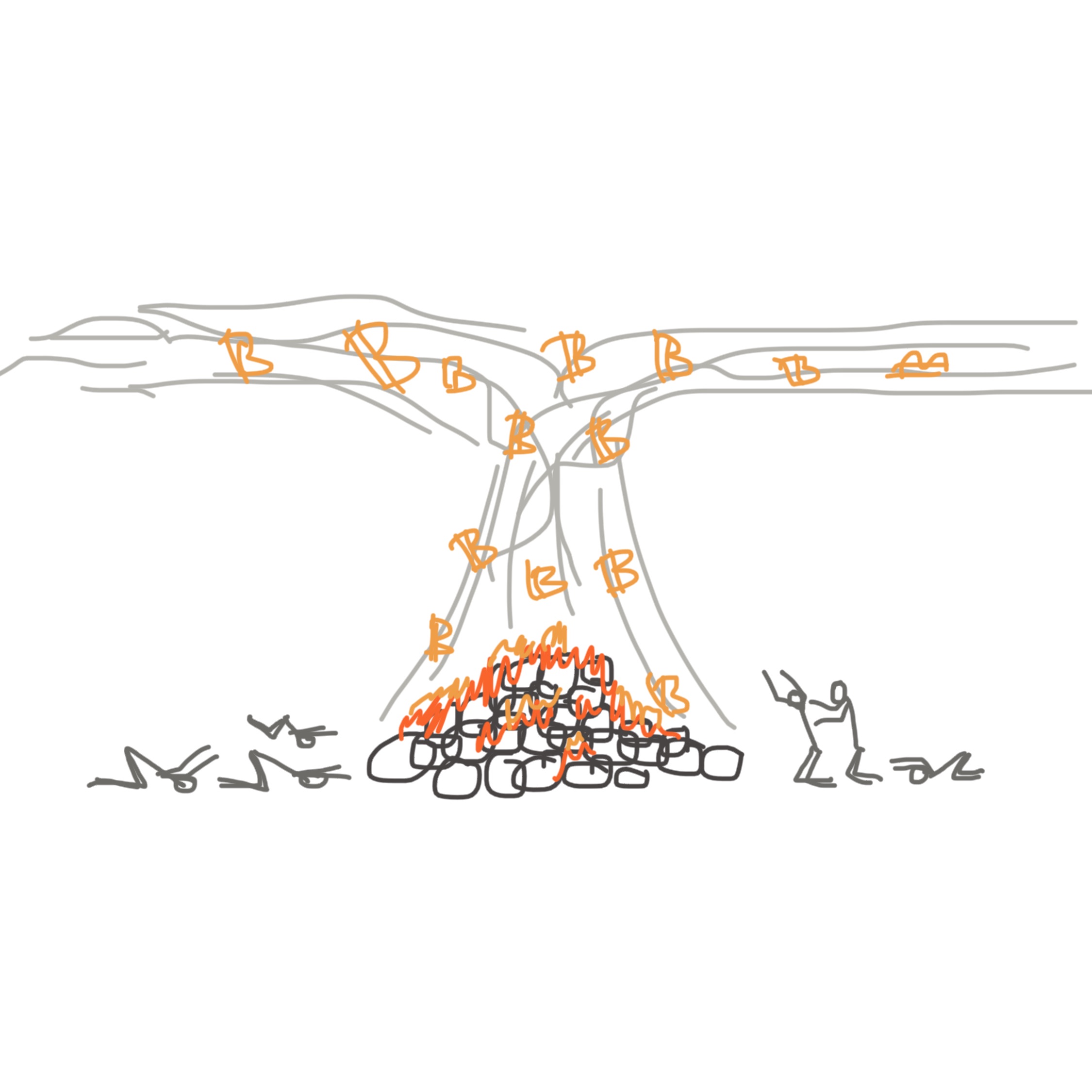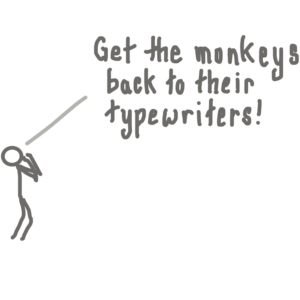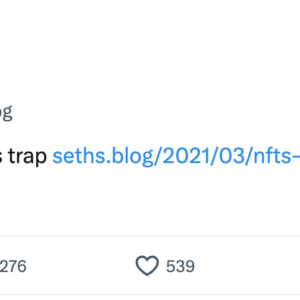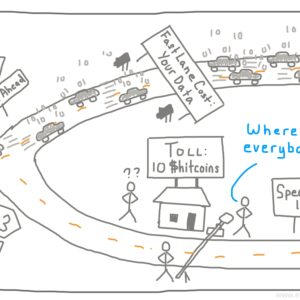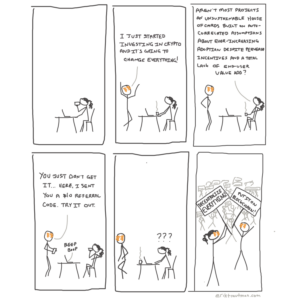Why I’m Interested in Blockchain
It started as a weekend project. A VC friend had put me in touch with one of his portfolio founders with a “you two should connect, I think you’ll really get along.” Suddenly I’m back in middle school and my mom is setting me up on play dates.
Wanting to have a better understanding of what they were working on, I took a look through their website and rolled my eyes when the word “Blockchain” came up. Not another one.
I was several months past the acquisition of my previous company and, during the scale-out phase, had gotten deep into artificial intelligence research. At the time, I was closing in on some interesting opportunities in the space and had a lot of momentum going. The tech is interesting, the problems are big and the space is highly active. I didn’t see any reason why I wouldn’t continue down that path.
Still, not wanting to roll in to our coffee playdate empty-handed, I decided to take the weekend to get up to speed on the technology behind this startup. And, like Alice in Wonderland, I stumbled straight into the rabbit hole.
Blockchain (into which I’ll incorrectly lump both crypto and [distributed ledger technologies] for convenience here) looks like a tire fire from the outside because the hype, lies and misconceptions are stronger than any market I’ve been a part of. But, below the oily smoke of misinformation and beneath the hard surface of misguided dogmatism, there is something truly extraordinary going on. Some of the smartest people in the world are working on real problems that draw on just about every discipline of study or experience that I’ve ever had exposure to. These aren’t just toy problems, but problems with broad implications that completely begin to rewrite the fabric of human interaction.
Naturally, I was highly skeptical. But, the more I read, the more the thread kept gently tugging me deeper and deeper until I was irrecoverably lost.
It can be tough to see that “oh, another one lost to the Dark Side” look on the face of people when you say you’re working in the DLT/blockchain/crypto space. I get it because I used to wear it too.
Let me show you why that changed.
When venture capitalists evaluate startups, they often ask three questions which get to the heart of this Why:
- “Why this?”
- “Why you?”
- “Why now?”
Why, indeed?
The Search for Hope
It starts with hope. When I traveled through India earlier this year, it was a very challenging experience. My faith in humanity, which was already pretty battered, hit a new low as I immersed myself for a month in the pollution and suffering around me. It was very difficult to experience the highs of energetic people and beautiful places but see such stark attitudes of careless destruction of both people and environment everywhere I turned, exacerbated as they were by high density and poverty.
When I returned, I needed to believe.
I needed to believe that mankind could progress forward without destroying everything in its path. That we weren’t just an unsustainable virus doomed to a Malthusian death trap on a dead earth under the boot of authoritarian leaders. So I put on my Indiana Jones hat and began a quest for the hidden statistical artifacts of a positive future.
I found hope, albeit a tenuous one. For us to achieve a future where mankind lives in harmony with our world and ourselves, we have to win on three key dimensions:
- Population
- Ecological Impact
- Freedom, Philosophy and Governance
Essentially, it comes down to the following question: “Can we stabilize our population while reducing our ecological impact to a sustainable level while ensuring that we are still free to live joyful, meaningful and fulfilling lives?”
And, hidden in the data, there are just enough nuggets to believe that, despite how much effort is required and how much dead weight we’re pulling with us, it is indeed just possible. But it requires us to master every tool and trick in the book to get people to alter their individually focused patterns and act in a way which benefits out collective survival as a species. This requires a mastery of incentives that we’ve only begun to explore.
And that brings us back to blockchain.
Why Blockchain?
While it may seem unintuitive at first, blockchain is about nothing less than the redesign of behavioral systems whereby potentially adversarial actors can be united by economic self-interest to operate for the collective good of the ecosystem.
As a familiar example, capitalism uses the “invisible hand” of motivated self-interest to result in the construction of everything we see around us. Players often operate adversarially but, ultimately, the creations of their aggregated self interest forward the goals of the system itself.
Blockchains and the robust tokenization they facilitate allow us to apply this abstraction in a highly intentional way to an infinite space of new markets and collectives. Essentially, it means that we can create incentive structures to motivate overall behaviors from players who are otherwise unmotivated to act collaboratively for those same goals.
As an example, the Bitcoin network creates billions of dollars of transactions every day by providing incentives for each player in the system — from the buyers and sellers to the miners who solve the blocks to the developers who manage the protocol to the governors of the overall project — to operate in the best interest of the system overall. All while assuming that just about every single one of them is trying to lie, cheat and steal wherever possible. That is an astonishing feat.
Other networks take this principle and apply it in similar ways. With [Ethereum], we’ve created a global supercomputer by motivating participants to write, run and verify efficient code. With [IPFS], we’ve incentivized spare storage to enter the market. With [Regen], we’re incentivizing the creation and maintenance of a ledger for managing ecological impact. And so on.
As important as WHAT we can now do is HOW it is being done.
These incentive structures exist and persist precisely because they have been constructed in a way which is decentralized and thus highly resistant to the interference of strongman parties operating to co-opt the system’s resources for their personal gain.
One example of this is how a decentralized network, which runs across thousands of computers around the world, can’t be shut down by a single government’s censorship. Another is how the open-source nature of the software and distributed storage of information makes the core protocols significantly more secure against broad-scale hacking.
And, finally, the lack of reliance on centralized corporations for gatekeeping prevents these same corporations from extracting rents on behalf of their shareholders, acting as poor custodians of users’ trust (or data) and arbitrarily cutting off access to valuable services to prevent competition.
As an engineer, I find the mechanisms of HOW all these things are achieved endlessly fascinating and hugely appealing but, ultimately, it’s the big picture that represents the most compelling reason not just to play with it but to believe that blockchain technology and all it represents could potentially effect real change in our world.
Why You?
I’ve played a wide range of roles in the last 15 years.
Learned the foundations of deep logic in engineering. Used probability and game theory to succeed at poker. Dove deep into markets and strategy on Wall Street. Following the call to create real value, I left and started one of the most widely used [open source learning] communities. Created content, translated difficult concepts into models and developed products on the journey of founding a technical education company.
Not only that, my life was changed when I began going to Burning Man and that experience led me to help start a communal house in San Francisco and join a network of similarly minded houses who seek to challenge the status quo and question the core assumptions about the world we live in.
I never quite found a way to tie it all together until now.
Effectively using blockchain as a tool for value creation and change requires a huge breadth of skills. The deeply technical side spans systems design, security and architecture. Behavioral elements including market design, incentive structures and governance are just as important. The open source projects live or die on strong community building and project management. And a healthy dose of user-centric product thinking is essential to bridge the difficult and wide gap that currently exists between visionary techno-utopianism and actual usage by real people.
I can say that, on a personal level, I’ve never experienced a space that requires the firing of so many neurons from different areas of my brain or draws on so many of my past experiences.
And there is yet so much to learn, so many creative connections to make between ideas, that a tantalizingly engaging road of endless learning lies ever ahead.
Why Now?
Let’s be realistic – this space has warts.
There is the Dark Web, hacking, fraud, overhyped expectations, bubble mentality, crazy people getting rich, stupid people gaining influence and every other obfuscating dynamic you can throw in the way of intelligent conversation and progress. Yet beneath (and in spite of) the bullshit layer, blockchain has a lot to offer.
We’ve proven that a killer use case for blockchain technology is the creation of crypto currencies, which currently facilitate transactions that are multiple orders of magnitude better/faster/cheaper than the previous system could offer. There is also a fascinating future where the digital, gaming and mixed reality world will be transformed by the scarcity of tokens. And, most importantly, we’ve yet to find the end of what problems tokens can be applied to solve.
There have been and there certainly will be a lot of false starts. The hype cycle will turn vicious and entrenched interests will continue to be vocally resistant to new ideas. Lots of projects will fail, leaders will be outed as frauds and everyone will say “I told you this was just another stupid waste of intelligent peoples’ time.”
That has been the story of innovation since the beginning. Meanwhile, the best minds in the world will continue to focus on bridging to the future and will drag the rest kicking and screaming along with them when, overnight, the value will start becoming apparent as the infrastructure and tooling breaks key thresholds.
As the underlying infrastructure layer begins to stabilize and the deep technical work achieves realization, it’s the job of the creatives to take the hand-off and continue the masterpiece. This is where the founder generalists, the maverick executives and the product people need to see where the ball is going and connect with existing — and new — user needs when it arrives.
This is where we are now.
We finally have the first layer ready and the tools at hand to figure out incentive systems to change human behavior in support of a broader whole. We have the ability to rapidly test ideas or markets and governance structures that used to require the lifespan of nation states to prove out. And we’re desperately close to unlocking new solutions to building a shared future.
Our problems won’t wait so we can’t do this soon enough.
Why blockchain?
Back to where we started, I can sum my own interest as following three dimensions:
It’s challenging. Founders, funders and developers are engaged in a Darwinian struggle in a highly competitive marketplace to create value before the tide goes out and everyone is left stranded. The speed and energy of innovation is astonishing.
It’s creative. There are castles being architected and markets being designed to breathe life into ideas that only ever lived in the heads of academics.
It’s potentially the transformative change we need. Our path to the future is currently in a bad shape and only by figuring out and implementing alternative systems of incentives can we shift course towards a positive outcome for us all.
You can choose to write off the exodus of talent into the blockchain space as a wasted, misplaced risk but don’t do the disservice of making that judgement without fully appreciating the upsides of possibly getting it right. We’ll screw up a lot along the way and it may never end up being more than a digital currency for libertarians, cypherpunks and criminals but the upside potential is impressive.
So… why blockchain?
Because we need a canvas on which to create a better world for our children and I want to be a part of painting them that future.

